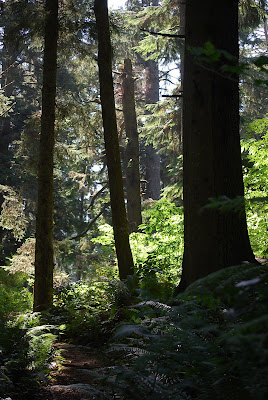As we usually do, we walked in silence, carefully maneuvering the dirt trail as it wound through the woods between trunks of huge ancient cedars and moss-covered maples. In mid May, this part of the world is a virtual sea of green with new growth erupting everywhere. Fresh and new, with none of the ragged bug nibblings nor dust coatings that come later in the season, each stem and leaf stood out from the others as clearly as in today’s best quality High Definition TV. Only this was the real thing. Lining the path as far ahead as we could see, spring blooms added a sprinkling of color - native Geranium, Bleeding Heart, Fringecup, Star Flower, Trillium, and others I didn’t know. Dainty, delicate Maidenhair ferns trembled as we passed, while stately Sword Ferns stood at attention, their new growth stiffly upright, leaving older, browning fronds to sprawl out near the ground. Overhead, those giants of this valley - the venerable maple trees - spread their branches and speckled the sky with sap-green leaves, creating the effect of a massive, hushed cathedral. Within Dosewallips State Park, Maple Valley can be a magical place.


As we walked, soaking up the ambiance and noting thick growth of moss, shelf fungi and nurse logs, a single, clear melody drifted into our consciousness. It’s not unusual to hear birds singing in the forest, especially in the spring, but this one was distinct. It sang solo and loud - no one sang back. A few more twists and turns of the trail brought us closer to the songster and we stopped, scanning the undergrowth until we spotted him. There ahead, among thick vegetation on the forest floor, a small dark brown bird perched on the tip of an upright dead branch and sang his heart out. Enthralled by his extended complex song, we edged closer, sure that he would fly away on seeing us. But he did not. Twitching about on his small podium, stubby tail held stiffly upright, he clearly sang for all the world to hear - and that included us.
The Winter Wren is a tiny woodland bird whose song is as elaborate as its plumage is drab. Although a common, permanent resident of western Washington, it is somewhat shy and secretive, so is seldom seen. It eats mostly insects and spiders, so does not frequent feeders. It is found most often in closed-canopy forest such as Maple Valley, but lives in other forest types as long as there is dense understory. Only the most observant - and fortunate - humans find them creeping about among brush piles, fallen logs, and stream banks in these areas. In Spring, males establish and defend territories and attract females by singing, so this one’s solo performance served a very important purpose for him. To us it was pure, melodic joy being poured out into endless forest and uplifting our very souls.


We moved on quietly, leaving the little wren behind to flit through the undergrowth and continue his song. And as we proceeded through this green cathedral a song rose in my own heart - “Sing out, earth and skies, sing of the God who loves you! Raise your joyful cries! Dance to the life around you!... ”
Shout for joy to the LORD, all the earth.
Worship the LORD with gladness;
come before him with joyful songs.
Psalm 101:1-2




No comments:
Post a Comment